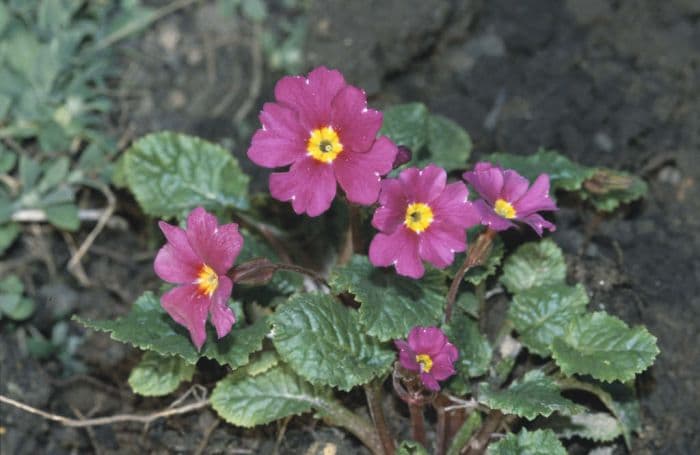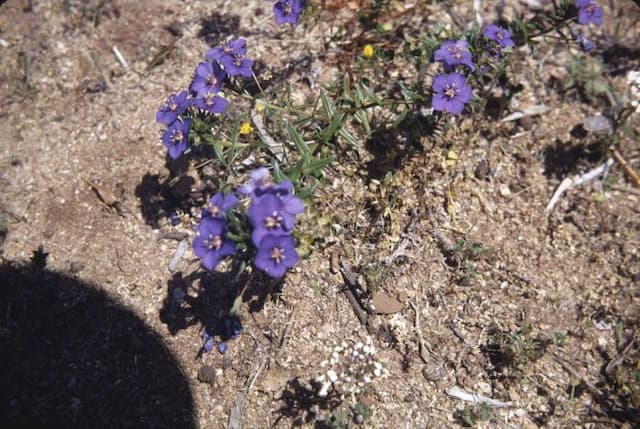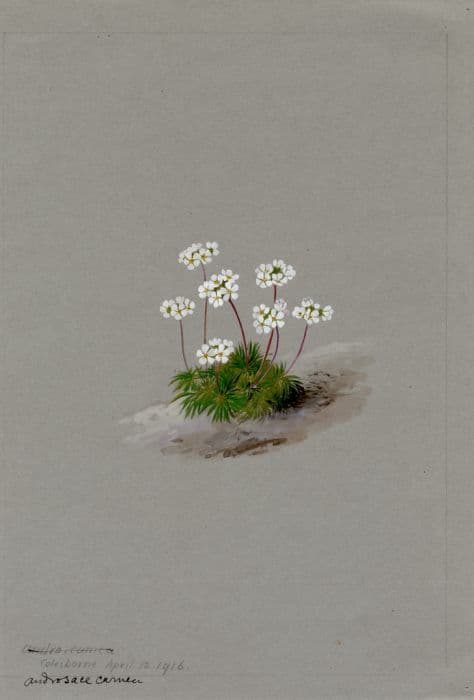Wanda Primrose Primula 'Wanda' (Pr/prim)

ABOUT
Primula 'Wanda' is a charming perennial known for its vibrant and colorful blooms. The plant showcases a lush rosette of tongue-shaped leaves that are a rich green in appearance. These leaves form a dense and textured mat upon which the flowers stand prominently. The blossoms of the Primula 'Wanda' are particularly eye-catching; they grow in clusters atop sturdy, upright stems that rise from amidst the foliage. Each flower boasts a circular shape with a slightly ruffled edge, giving the blooms a quaint, old-world charm. The flowers present a palette of vivid colors, which may include shades of purple, red, blue, yellow, and pink, often with a contrasting yellow or white eye at the center that lends additional allure to the already striking flowers. With their saturated hues and cheerful aspect, the flowers of Primula 'Wanda' are a highlight of the early spring garden, often being one of the first plants to bloom and signaling the end of winter with their bright and hopeful display.
About this plant
 Names
NamesFamily
Primulaceae
Synonyms
Wanda Primrose, Wanda Group Primrose
Common names
Primula 'Wanda', Primula obconica 'Wanda', Primula malacoides 'Wanda'.
 Toxicity
ToxicityTo humans
Primroses, including Primula 'Wanda', are generally considered to be non-toxic to humans. Ingesting parts of the plant typically does not lead to serious poisoning or life-threatening symptoms. However, it's possible for some individuals to experience mild stomach upset if they consume parts of a primrose.
To pets
Primroses, such as Primula 'Wanda', are also generally non-toxic to pets. They are not known to cause serious harm if ingested by animals like cats or dogs. As with humans, the most common result of a pet eating parts of a primrose might be mild gastrointestinal upset, including nausea or vomiting.
 Characteristics
CharacteristicsLife cycle
Perennials
Foliage type
Evergreen
Color of leaves
Green
Flower color
Varies
Height
6 inches (15 cm)
Spread
6 inches (15 cm)
Plant type
Herb
Hardiness zones
5
Native area
Europe
Benefits
 General Benefits
General Benefits- Easy to grow - Primula 'Wanda' is known for being a hardy plant that's relatively simple to cultivate in a variety of garden settings.
- Colorful blooms - It produces vibrant flowers that add a splash of color to gardens, particularly in the spring when the blooms first appear.
- Attracts pollinators - The flowers attract beneficial pollinators such as bees and butterflies, which are essential for the health of gardens.
- Compact size - Due to its small stature, it is suitable for growing in containers or small garden spaces.
- Long blooming period - Primula 'Wanda' has a relatively long flowering period, providing visual interest over an extended season.
- Versatility - It can be used in various landscape designs, including rock gardens, borders, and woodland settings.
- Shade tolerance - Primula 'Wanda' can thrive in partial shade, where many other colorful blooming plants may not perform as well.
 Medical Properties
Medical PropertiesThis plant is not used for medical purposes.
 Air-purifying Qualities
Air-purifying QualitiesThis plant is not specifically known for air purifying qualities.
 Other Uses
Other Uses- Photography Prop: The Primrose 'Wanda', with its vibrant colors and compact shape, can be used by photographers as a natural prop to add beauty and depth to spring-themed photo shoots.
- Natural Fabric Dye: The richly colored petals of the Primrose 'Wanda' can be used as a natural dye for fabrics, yielding hues that range from pale yellow to deep violet, depending on the mordant used.
- Educational Tool: Educational institutions may use Primrose 'Wanda' to teach students about plant biology, pollination, and horticulture, providing hands-on learning opportunities in botany classes.
- Ice Cubes Decoration: Petals from the Primrose 'Wanda' can be frozen in ice cubes to create an attractive and edible embellishment in drinks for garden parties and spring events.
- Art Supplies: The petals and leaves of Primrose 'Wanda' can serve as natural materials for art projects, like pressing for botanical illustrations or creating environmentally friendly confetti.
- Culinary Garnish: Safe to eat, the flowers of the Primrose 'Wanda' add a splash of color and a subtle flavor when used as a garnish on salads and desserts.
- Plant-based Inks: The pigments extracted from the flowers of Primrose 'Wanda' can be used in the creation of natural inks for writing or drawing.
- Bookmarks: Dried and pressed Primrose 'Wanda' flowers can be laminated to create unique and attractive bookmarks.
- Biodegradable Potpourri: The fragrant flowers of the Primrose 'Wanda', when dried, can be mixed with other botanicals to create a natural, biodegradable potpourri.
- Eco-Friendly Wedding Favors: Small potted Primrose 'Wanda' plants can be gifted as eco-friendly, living wedding favors that guests can take home and grow, serving as a memento of the special day.
Interesting Facts
 Feng Shui
Feng ShuiThe Primrose is not used in Feng Shui practice.
 Zodiac Sign Compitability
Zodiac Sign CompitabilityThe Primrose is not used in astrology practice.
 Plant Symbolism
Plant Symbolism- Youth: The Primula, or Primrose, being one of the first flowers to bloom in spring, often symbolizes youth and renewal.
- Hope: Its early appearance brings hope and the promise of new life after the winter months.
- Love: Certain varieties of Primrose, including the 'Wanda', are associated with young love and affection.
- Constancy: The perennial nature of the Primrose reflects steadiness and reliability in the language of flowers.
 Water
WaterThe Primula 'Wanda', commonly known as the Wanda Primrose, prefers consistent moisture. It is best to water thoroughly when the top inch of soil feels dry to the touch. This may mean watering once or twice a week, but it's essential to adjust depending on weather conditions and the plant's environment. A general guideline is to provide the Wanda Primrose with about 1 gallon of water weekly during active growth periods. Ensure that the plant is in well-draining soil, and avoid overhead watering to prevent foliage diseases.
 Light
LightWanda Primroses thrive in partial shade, where they receive bright but indirect light for the better part of the day. They can tolerate morning sun followed by afternoon shade, or dappled sunlight throughout the day. Avoid placing them in full sun, especially in hotter climates, as it can cause stress and leaf scorch.
 Temperature
TemperatureWanda Primrose favors cool temperatures, thriving within a range of 50 to 70 degrees Fahrenheit and can tolerate minimum temperatures down to about 30 degrees Fahrenheit. Ideally, keep the Wanda Primrose in a location where nighttime and early morning temperatures are cool since this mirrors their natural alpine habitat.
 Pruning
PruningPruning the Wanda Primrose is mainly done to remove dead or faded flowers and to encourage further blooming. Lightly trim back spent flowers as they wilt to maintain a tidy appearance. Pruning can be done throughout the flowering season as necessary. The best time to do any major cutting back is immediately after flowering has ceased, to prepare the plant for the next season.
 Cleaning
CleaningAs needed
 Soil
SoilThe best soil mix for the Primrose should be rich, moist, and well-draining with an addition of peat moss or compost to improve its structure. The ideal pH for the soil should range from 6.0 to 7.0, which is slightly acidic to neutral.
 Repotting
RepottingPrimroses should generally be repotted annually, preferably in the spring before new growth starts. This helps to refresh the soil and provide room for root growth.
 Humidity & Misting
Humidity & MistingPrimroses thrive in environments with high humidity levels, ideally between 50% and 70%. It is important to ensure good air circulation to prevent disease.
 Suitable locations
Suitable locationsIndoor
Provide bright, indirect light and high humidity for indoor Primroses.
Outdoor
Plant in partial shade with moist, well-draining soil for outdoor Primroses.
Hardiness zone
4-8 USDA
 Life cycle
Life cyclePrimula 'Wanda', commonly known as Wanda Primrose, begins its life cycle when seeds are sown in a well-drained, moist seed-starting mix, usually during late winter or early spring. These seeds germinate to produce tiny seedlings, which are then typically transplanted into individual pots or garden beds as they grow larger. The plant enters a vegetative stage, during which it forms a rosette of leaves. As maturity progresses, the Wanda Primrose produces clusters of colorful flowers, usually in shades of purple, red, or pink, blooming in late winter to spring, depending on the climate. After flowering, the plant sets seed, which can be collected for propagation or allowed to self-sow in the garden. The plant may go dormant in the heat of the summer or after flowering, and it often exhibits perennial characteristics by re-emerging from its rootstock the following spring.
 Propogation
PropogationPropogation time
Spring-Early Summer
Propogation: The Primula 'Wanda', commonly known as 'Wanda Primrose', is typically propagated during the cooler periods of early spring or late summer to early fall, to avoid the stress of midsummer heat. The most popular method of propagation is by division. This is performed by carefully digging up an established clump and gently teasing apart the individual plants, ensuring each has a section of roots. These individual plants are then replanted at the same depth they were growing previously, ideally spaced about 6 to 12 inches (15 to 30 centimeters) apart to allow room for growth. Watering them in well after planting is crucial to help establish the new divisions. Division helps to rejuvenate older clumps that have become woody in the center and encourages vigorous growth and flowering.









